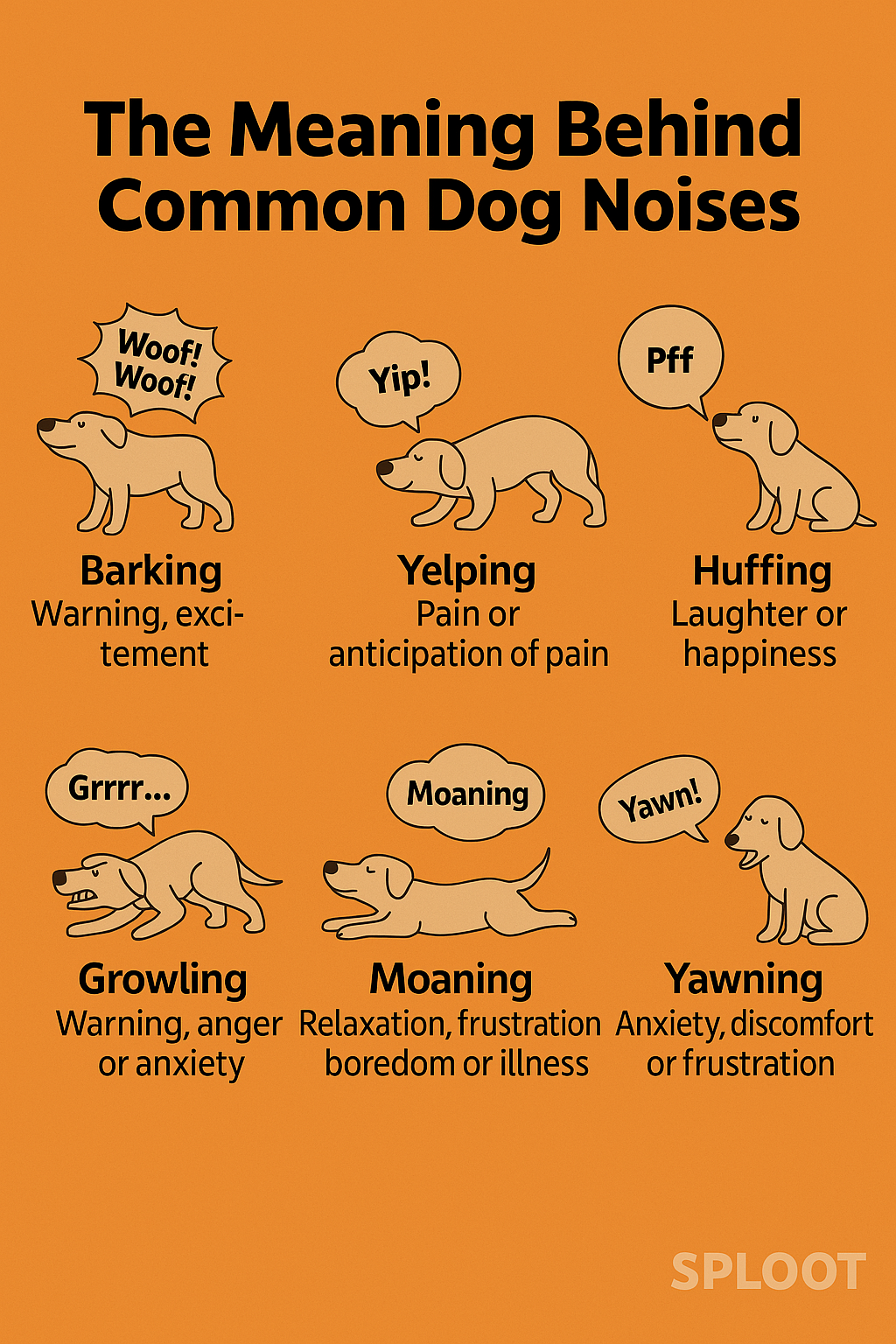People seem to be under the impression that dogs bark at will. Barking, together with tail wagging and body language, is their means of communication with both humans and other dogs.
Barking varies in pitch, tone, and frequency, with each tone denoting a different message- some might convey fear or distress while others would express exuberance and fun. People and sometimes new pet parents fail to interpret these barks and are unsure about what the dog is meaning to communicate to them.
Understanding your dog’s vocal communication and barks will help you build a better bond with them and help you provide them better. This article explores many such cues, what they mean, and tips on how to respond to those appropriately.
Deciphering Dog Barking Sound Meaning

Along with tail wagging and body language, dogs most often use barking as a form of communication. Their vocal communication is also the most noticeable form of communication to humans.
There are various things to take into account regarding barking: breed, setting, and training. Vocal dogs include some dog breeds like Spitz and Beagles, which usually bark more than others. It is also likely that stray dogs or guard breeds will bark a lot due to external stimuli, as they are more aware of their surroundings.You can interpret your dog’s emotions when you understand your dog’s type of barking and their meanings.
Understanding Types of Dog Barking Sound
- Single Short Barks
- A single, short bark may generally serve as an acknowledgment or a greeting. Such a bark is given when someone gets home or when a dog spots someone it knows. It can also suggest a slight sense of thrill when a dog is waiting for a treat she's been promised, for instance, or some other fun.
- Repetitive Barks
- When dogs bark repetitively, it is most likely indicating some kind of urgency. The intensity and rapidity of the barking will characterize its nature. Fast, frantic barking indicates very high levels of excitement, only sometimes bringing a caution about something the dog perceives as a threat-on approach of a stranger or some unusual noise. Slow, spaced-out barking might mean that the dog is either trying to get the attention of something in the surroundings or is hesitating about something going on with it.
- Howling
- Howling is used by dogs to talk over a long distance. It's instinctive to communicate from afar and quite often is triggered by sirens, musical instruments, or the howling of other dogs. Excessive howling may also speak of separation anxiety or a strong emotional response to feelings of loneliness.
- Whining or Whimpering
- A pitchy whining or whimpering sound generally indicates something is wrong or someone in need of something. Young pups do this to convey their needs to their mother. In a similar way, an adult dog may whimper when they desire attention, feel pain, or are emotionally distressed.
- Growling
- Depending on the context, pitch, and style of the growl, this can mean that the dog is being playful or that the growl is an aggressive one to warn others away. A dog growl can vary from a deep and prolonged sound indicating aggression or discomfort, to a softer sound given playfully with relaxed body language.
- Snorting or Huffing
- Dogs can snort or grunt, short little huffy noises often done when it gets frustrated, annoyed, or impatient. It could include things like being refused food or being denied a walk. Sometimes it can seem closer to a sign of excitement.
- Mumbles and Low Grumbles
- Some of the talkative breeds like Siberian Huskies, for instance, mumble or grumble as a sort of communication with their humans. Such sounds are often audible on occasions when the dog is relaxed but still in some engagement of what we may consider a "conversation" with the humans.
Understanding Pitch, Volume, and Frequency of Dog Bark
- High-pitched barks
- High, yappy barks usually signal excitement and eagerness, or, in some cases, distress. Barks of this kind often accompany greetings, playtime, or attempts at getting someone's attention.
- Low-pitched barks
- A low, deep bark is often meant to be a warning. Here, the dog is trying to alert its owner or another person of a possible intruder-a person or other animal.
- Long-drawn barking
- Nonstop barking for long periods of time means this dog is excited or filled with more intense emotions like fear or separation anxiety.
- Fast, continuous barking
- Rapid, continual barking signifies excitement or alertness in a dog. Such activity is often prompted by something in the environment that activates the dog's reactivity.
- Intermittent, irregular barking
- When dogs bark unevenly with breaks in between, it could indicate confusion, an attempt to attract attention, or an evaluation of a situation before acting further with it.
Understanding the Mood from the Dog Barking Sound
- Happy & Excited
- A playful dog usually barks in short bursts and in a high pitch, moves its tail, and displays playful body movements.
- Sad & Lonely
- When dogs howl or whine intermittently, they may be feeling lonely and sad. The interpretation of this is their craving for companionship or some kind of comfort.
- Aggressive & Defensive
- The stiff, loud barks or deeply growled sounds would indicate aggression or a defensive stance. This occurs in fact whenever a dog feels threatened and is just about to hold his ground.
- Urgency or Danger
- If a dog barks quickly and continuously, it may be informing its owner of something like a trespasser on the property or a strange noise at the door that might require more immediate action.
- Discomfort due to Health Issues
- Dogs in pain or those dealing with an illness might do a little more of whimpering or low-energy barking. If a normally quiet dog suddenly starts whimpering over and over, one should be sure to find out if something is wrong or to see a veterinary doctor if needed.
How Understanding Dog Barking Helps Pet Owners
Barking is one of the vital communication means for dogs; therefore, understanding these cues is essential to bond well with your dog and be a more responsible dog parent. Understanding and recognizing the different barks will help in rehabilitation, training, and provision of needs. Continuous crying or whining could also indicate health issues which may need medical intervention.
Barking also plays a key role in home security– especially if your dog is a guard dog by breed. This is quite essential when it comes to differentiating between an alert bark, an aggressive bark, and some kind of casual noise. Understanding the subtle differences in the barks of your dog and the meaning behind it strengthens the bond between you and your dog, creating a happier and healthier one.
Join the sploot Community
Because dogs cannot communicate verbally, they bark. As a good pet parent, you ought to understand the various sounds they make, and what those sounds really mean. By identifying that your pup is happy, sad, angry, or jealous, you will know how best to react to him. This creates a bond and also enhances their quality of life. Want to learn more?
Download the sploot app to connect to other pet parents, seek expert advice, and check out our services and products.
Join our AMAs, Pup Talks, and exclusive events to extend your learning about dog behavior and care. Don’t forget to follow us on Instagram for daily tips, feel-good pet stories, and discussions about dog parenting!
FAQs on Dog Barking Sound
Does the meaning of dog barking sound depend on its pitch and duration?
- Usually, a short bark that is higher in pitch most probably indicates excitement or a friendly type of greeting; conversely, a long one with a lower pitch may mean a warning or a threatened situation. It's also worth noting how long the bark lasts and how many times the dog repeats it, indicating how urgent or intense it is.
What does dog barking reveal about a dog's mood?
- A happy dog may give high-pitched, short bursts; anxious or frustrated barking is more prolonged and urgent. Aggressive or defensive barking is deeper and more intense.
What does it signify if a dog barks four times in a row?
- Four or more sequences of barks spaced equally most times indicates alertness or a call for attention. It could mean that the dog has noticed something unusual and intends to inform its owner about it.
How does understanding dog barking sound meaning improve communication with your dog?
- Knowing different barks can help owners respond appropriately, comforting the anxious pup, rewarding the good behavior, or managing potential threats. And this strengthens trust, therefore, making the training more effective.
Why does my dog bark early in the morning, like at 3 AM?
- Disturbances, separation anxiety, or pent-up energy may cause dogs to bark at night. Barking can be stimulated by environmental noises, nocturnal animals, or a dog's need to be let out.









